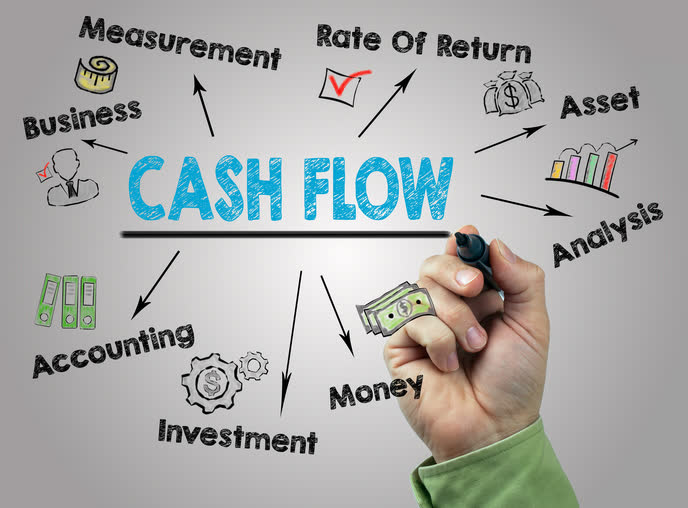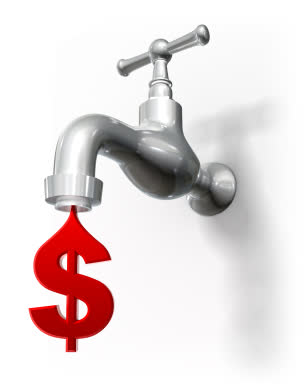Dividend Value Builder Newsletter
Types of Cash Flow and Cash Flow Calculations Guide


Are you ever confused by the different types of cash flow for investment analysis?
I believe you will find this a useful guide to the different types of cash flow and cash flow calculations, along with practical step by step comparisons and uses for each metric.
What is Cash Flow Analysis?
Cash flow analysis is the examination of cash inflows and outflows of an entity. A company’s cash flow statement provides a bond between the income statement and the balance sheet . It allows an analyst to determine where the company’s cash was produced (inflows) and dispersed (outflows) during a specific period of time (usually a year).
Why is Cash Flow Analysis Important?
Cash flow calculations provide information on profitability, quality of earnings, liquidity, risks, capital requirements, future growth, dividends, etc. They are some of the most important tools for value investment analysis of investment opportunities.
Investors looking at investment opportunities should ask: Is the entity generating enough cash to sustain its’ business, grow its’ business, and provide returns to stakeholders? Cash flow metrics can be invaluable for comparison research and ratio analysis with enterprise value, or various other measurements.
Different Types of Cash Flow
I have put together a summary of the different types of cash flow calculations for investment analysis. Let’s start with the three types of cash flow in the cash flow statement:
Cash Flow From Operations
Cash Flow from Operations measures the cash generated from the core business or operations of the business.
Cash Flow From Operations (CFO) = Net Income + Depreciation & Amortization +/- 1 Time Adjustments +/- Changes in Working Capital
Cash Flow From Operations is a line item in the Cash Flow Statement.
Cash Flow From Investing Activities
Cash Flow From Investing measures the purchases and sales of long term investments including items such as capital expenditures, acquisitions, or investments in other securities such as stock and bonds.
Cash Flow From Investing = Net Capital Expenditures of Property, Plant, and Equipment (PPE) +/- Long Term Investments
Cash flow from investing activities will usually be negative. For most companies this represents investment in itself. Cash flows would only be positive when investments are disposed of.
Cash Flow From Investing Activities is a line item in the Cash Flow Statement.
Cash Flow From Financing Activities
Cash flow from Financing measures the activities that fund the company and stakeholders (debt and equity holders). These activities include issuing or buying back stock, issuing or repurchasing debt, and paying dividends to shareholders.
Cash Flow From Financing = Cash Received From Issuance of Equity or Debt – Dividends to Shareholders – Purchase of Outstanding Equity or Debt
Cash Flow From Financing Activities is a line item in the Cash Flow Statement.
Note: The above cash flows are segregated and detailed in the Statement of Cash Flow. The sum of the three makes up the Total Cash Flow for the entity.
Total Cash Flow
Total Cash Flow = Cash Flow from Operations +/- Investing Cash Flow +/- Financing Cash Flow
Total Cash Flow of the entity is the sum of the Cash Flow from all activities including operating, investing, and financing activities. It is the total you find at the bottom of the Cash Flow Statement labeled “Change in Cash and Cash Equivalents”. The Total Cash Flow of a period of time will equal the difference between the entity’s cash balance at the beginning and ending of the time period.
Cash Earnings
Cash Earnings = Net Income + Non-Cash Expenses (i.e. Depreciation & Amortization)
Cash Earnings of Net Cash Flow or Net Income Plus Depreciation (NIPD) is the profits (or loss) of the entity plus non-cash expenses (i.e. depreciation and amortization).
This metric includes the financing and investing activities that are included on the income statement, but excludes financing and investing activities affecting the balance sheet.
Personally, cash earnings is one of my favorite metrics because it isolates the operations income. This is the cash earnings power of company operations. Management can do one of three things with cash earnings: 1) reinvest it in the business 2) pay down debt or 3) return it to shareholders through dividends or buybacks.
Owner Earnings
Warren Buffett has promoted the concept of “Owner Earnings”. Owner Earnings takes it one step beyond Cash Earnings by subtracting the approximate amount of capital expenditures it takes to keep the company a going concern. This is calculated:
Owner Earnings = Net Income + Non-Cash Expenses (i.e. Depreciation & Amortization) – Average Annual Maintenance Capital Expenditures
(Note: An estimate is made of Maintenance Capital Expenditures. This is the CAPEX required to maintain the company and does not include CAPEX required for growth.)
What is left is theoretically for the company stakeholders (debt & equity shareholders). Options would include reinvesting for growth, debt reduction, dividends, and stock buybacks.
Interested in Intrinsic Value Stock Analysis?
Interested in Dividends?
Owners’ Cash Profits
Owners’ Cash Profits is a slight variation of Owners’ Earnings. Here, Cash Flow from Operations is used instead of Net Income; therefore changes in working capital are included in the equation.
Owners’ Cash Profits (OCP) = Cash Flow form Operations (CFO) [Net Income + Depreciation & Amortization +/- one-time adjustments +/- Changes in Working Capital] – Estimate of Maintenance Capital Expenditures
(Y-Charts uses this metric instead of Owners’ Earnings)
Free Cash Flow
Free Cash Flow = Cash Flow from Operations – Capital Expenditures
Free Cash Flow is Cash Flow from Operations less capital expenditures. It is the cash available to debt and equity holders after the expenses and taxes are paid and capital expenditures have been deducted.
The difference between Owner’s Cash Profits and Free Cash Flow is Free Cash Flow would deduct all capital expenditure, including any extraordinary expenditures used to grow the company. Owners’ Earnings and Owners’ Cash Profits only subtract the average capital expenditures or those needed to sustain the company.
A positive free cash flow means the company has enough cash inflows to maintain operations and meet its capital expenditure plans. A negative free cash flow means the company needs to use cash reserves, or raise cash through the sale of assets, stock or debt. In the long run, a company cannot have negative free cash flow and remain a going concern.
Net Free Cash Flow Calculation
Net Free Cash Flow is Free Cash Flow less the current portion (1 year) of long term debt, and the current dividends the company currently intends to pay (1 year).
Net Free Cash Flow (NFCF) = Free Cash Flow (FCF) – current portion of long term debt – current portion of future dividends.
This is a more conservative version of Free Cash Flow. A positive net free cash flow means the company has enough cash inflows to meet ALL the plans (operations, investments, and financing) of the company during the following year. A negative net free cash flow means the company needs to use cash reserves, raise cash from outside sources, or cut planned cash outflows.
Summary
Cash Flow is one of the most important investment concepts to understand. For the value investor it is more important than accounting profits because it paints an untainted or truer picture of the company and its finances.
Each one of the different cash flow metrics gives pertinent insight into the health of an entity. By using the different types of cash flow for investment analysis you will be greatly improving your ability to analyze and compare investment opportunities.
Related Reading:
Intrinsic Value Stock Analysis – My Formula
Minimize Large Portfolio Drawdowns
Invest With Confidence in Less Time - Manage Your Portfolio Without Behavioral Errors
